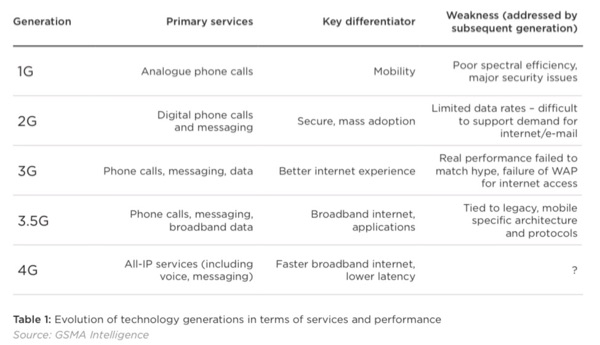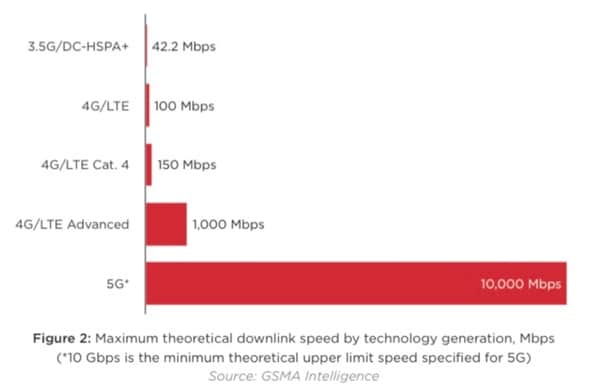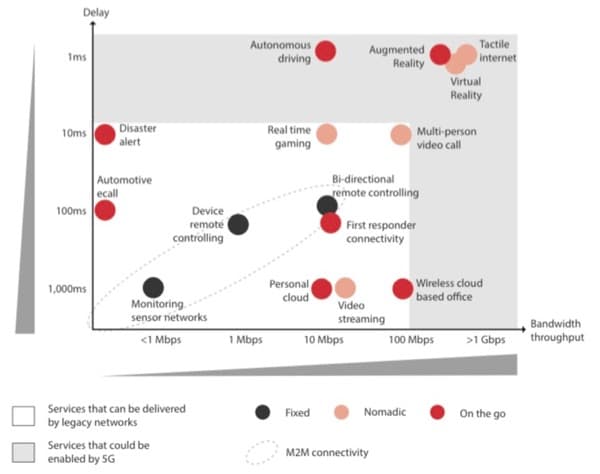
The fifth generation of wireless communication technology, called 5G, is now being tested. It invokes several new technologies, explained below, to achieve much higher speeds than 4G and provide much lower latency. Speeds in the multiple gigabit/sec (Gbps) range with 1 millisecond latencies are in the specification. That’s compared to 4G which offers about a hundred megabits/sec and much, much higher latency.
5G networks will utilize what’s called millimeter waves, that is, wavelengths of a few millimeters. The highest frequencies envisioned are about 58 GHz ( ~ 5 mm wavelength), but there are others with lower frquencies being tested. For the curious:
wavelength (mm) = 300 / frequency (GHz)
Wavelengths this short are blocked by physical objects such as buildings, trees and people. So 5G requires line-of-sight access. This makes for both transmission issues, which are being addressed by technical means, and antenna design issues which need to be solved.
The major carriers are currently testing 5G systems in some select cities, but it will probably be 2020 before the rollout can be considered widespread.
The susceptibility of millimeter waves to being blocked by surrounding objects will make for iPhone design challenges, and it seems unlikely that we’ll see iPhones with 5G support until this issue is resolved. I wouldn’t expect 5G support in 2018 iPhones based on this report from VentureBeat.
5G Specifications
According to the Global System for Mobile Communications (GSM Association), a 5G connection should meet most of these criteria.
- One to 10 Gbps connections to end points in the field
- One millisecond end-to-end round trip delay
- 1000x bandwidth per unit area
- 10 to 100x number of connected devices
- Perception of 99.999 percent availability
- Perception of 100 percent coverage
- 90 percent reduction in network energy usage
- Up to ten-year battery life for low power, machine-type devices
As quoted by Techworld, Paul Gainham, senior director, SP Marketing EMEA at Juniper Networks said:
Current 4G mobile standards have the potential to provide 100s of Mbps. 5G offers to take that into multi-gigabits per second, giving rise to the ‘Gigabit Smartphone’ and hopefully a slew of innovative services and applications that truly need the type of connectivity that only 5G can offer.
Here’s a helpful chart from the GSMA that recaps the development of the previous generations of wireless technology. (The charts below it are also from a GSMA paper, linked in the caption below each.)

The Problem With 5G
Higher frequencies used for 5G, 30 to 300 GHz, support higher transmission rates. That’s compared to about 1 to 6 GHz for 4G. But using much higher frequencies that can be absorbed by foliage, even rain, need special help. One such assisting technology is called “small cells”. These are a large, scattered set miniature base stations used to relay the signal. That will likely work out well in cities where there are many buildings and posts on which to places the relays, but not so much in isolated rural areas that will still have to depend on older generation networks.

Other New 5G Supporting Technologies
In order to reduce interference and make more efficient use of power, base stations will use beam forming technology. This is already utilized by many home Wi-Fi base stations. The technique shapes the beam and processes bounces to obtain a more efficient path to the device. This is combined with two other technologies that we are already familiar with: MIMO and Full Duplex operation.
MIMO stands for multiple-input multiple-output, and it uses multiple transmitters and receivers to send/receive more data at once than a single antenna could.
Full Duplex refers to the fact that 5G antenna systems and devices will be able to both send and receive data simultaneously. This will require redesign of the modem hardware.
The 5G Potential
5G will probably enable unforeseen capabilities as it starts to appear in mobile devices. Right now, I’ve seen 4K video, tactile internet, multi-person video calls, remote VR/AR, telemedicine, connected homes, cloud-based offices, autonomous cars and vehicle-to-vehicle collision avoidance mentioned as benefactors.

Summary
The 5G wireless technology promises an order of magnitude increase in average communication speeds. But this kind of speed doesn’t simply mean faster app downloads or browsing. While 4G has set the stage in our ability to routinely watch video on our phones, 5G will enable new ways of working and thinking. It may even be the beginning of the end, in most places, for coaxial cables strung into homes and businesses.
Looking forward to this non-lethal deployment. The military use millimetre waves to heat the skin for crowd control. Deployed to Afghanistan but never used?? The only “long term” cancer study exposures for millimetre waves have been for 10 second intervals over 2 whole weeks.
Can’t wait for this 24/7.
https://en.wikipedia.org/wiki/Active_Denial_System
Still wonder how this will work with the coming deployment of the ATSC 3.0 OTA TV signal which promises video streaming to mobile devices and includes a wireless component promised to be accessible from almost anywhere. Is 5G a stop gap measure until that arrives? Or maybe a cell phone only technology in addition to the ATSC 3.0 wireless bandwidth.
Your comment on coaxial lines reminded me of a conversation with a UVerse installer a few years ago. “If this phone is VOIP, what about the old copper landlines for phone?” The reply was that the copper will basically rot in the ground.